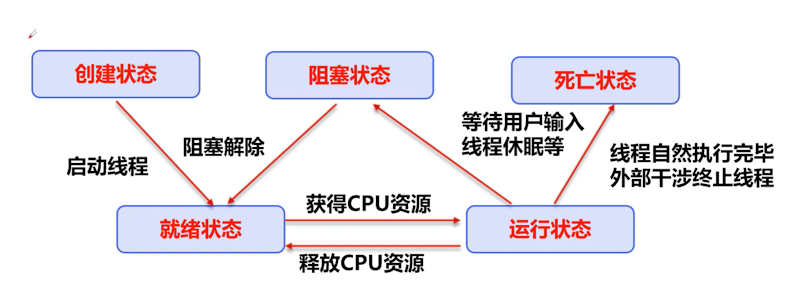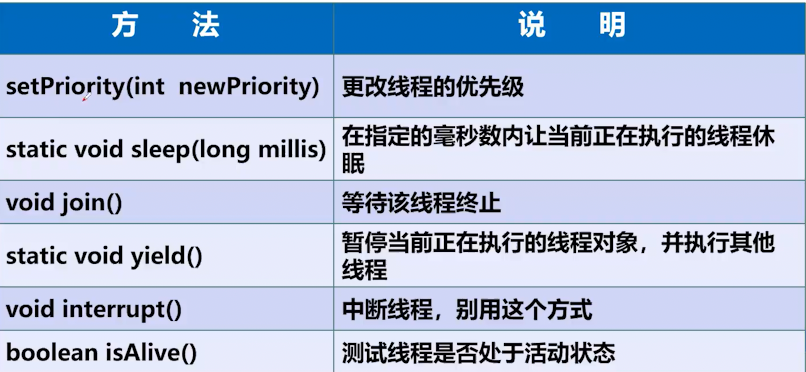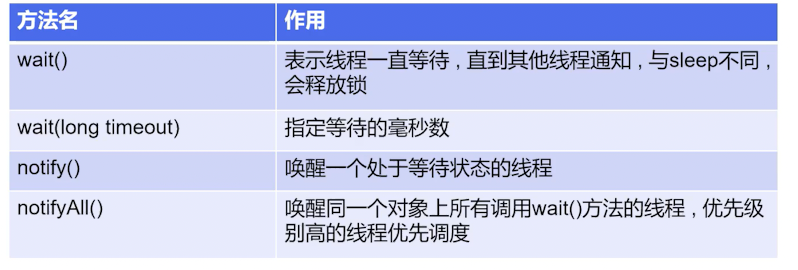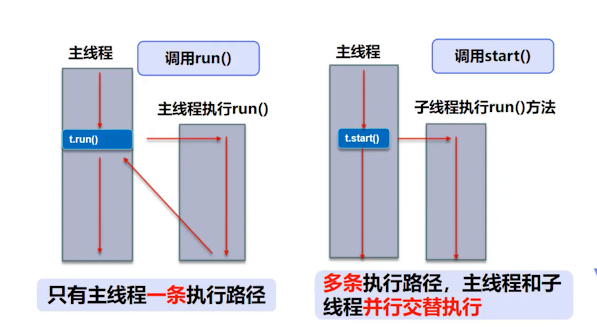Java学习笔记---多线程
多线程
基本概念
进程:程序执行一次的过程
线程:CPU调度执行的单位,一个进程可以包含若干个线程
核心概念
-
线程是独立执行的路径
-
在程序运行时,即使没有自己创建线程,后台也会有多个线程
-
main()为主线程,为系统的入口,用于执行整个程序
-
在一个系统中,如果开辟了多个线程,线程的运行由调度器安排,调度器于操作系统相关,先后顺序不可人为干预
-
对同一份操作系统资源,会存在资源抢夺的问题,需要加入并发控制
-
线程会带来额外的开销,如cpu的时间调度,并发控制的开销
-
每个线程在自己的工作内存交互,内存操作不当会造成数据不一致
线程执行顺序:
![]()
创建线程*
创建线程的方法 1
继承Thread方法,重写run()方法,调用start()方法开启线程
// 创建线程的方法一:继承Thread类,重写run()方法,调用start()开启线程
// 线程开启不一定立即执行,由cpu调度
public class TestThread extends Thread{
@Override
public void run() {
super.run();
for (int i = 0; i < 100; i++) {
System.out.println("Thread_1: "+i);
}
}
public static void main(String[] args) {
TestThread testThread = new TestThread();
testThread.start();
for (int i = 0; i < 500; i++) {
System.out.println("Main_thread: "+i);
}
}
}
import org.apache.commons.io.FileUtils;
import java.io.File;
import java.io.IOException;
import java.net.URL;
//练习Thread,实现同步下载图片
public class TestThread2 extends Thread {
private String url;
private String name;
public TestThread2(String url, String name) {
this.url = url;
this.name = name;
}
// 下载图片线程的执行体
@Override
public void run() {
super.run();
WebDownload webDownload = new WebDownload();
webDownload.downloader(url,name);
System.out.println("Download "+ name);
}
public static void main(String[] args) {
String url1 = "https://attach.52pojie.cn/forum/202103/14/094758zr7nbw7abxr5olz3.png";
String url2 = "https://attach.52pojie.cn/forum/202103/24/165010n97pp7ngn2nzgb2k.jpg";
String url3 = "https://attach.52pojie.cn/forum/202103/24/165012a521llx25518b99l.jpg";
TestThread2 t1 = new TestThread2(url1,"ph1.png");
TestThread2 t2 = new TestThread2(url2,"ph2.png");
TestThread2 t3 = new TestThread2(url3,"ph3.png");
t1.start();
t2.start();
t3.start();
}
}
class WebDownload{
public void downloader(String url, String name){
try {
FileUtils.copyURLToFile(new URL(url),new File(name));
} catch (IOException e) {
e.printStackTrace();
System.out.println("IO异常");
}
}
}
创建线程方法2(推荐使用)
- 创建一个类继承runnable接口,重写run()方法
- 执行线程时,主线程中创建Thread()类,将实现runnable 接口的类对象作为参数传入Thread类中
- 调用Thread类的start()方法,开启线程
//创建线程的方式2:实现runnable接口,重写run()方法,执行线程时将继承runnable类对象作为参数传输一个Thread()类中
// 调用start()方法
public class TestThread3 implements Runnable{
@Override
public void run() {
for (int i = 0; i < 400; i++) {
System.out.println("Thread_2:"+i);
}
}
public static void main(String[] args) {
// 创建runnable接口的实现类
TestThread3 testThread3 = new TestThread3();
// 创建线程对象,通过线程对象来开启我们的线程,代理
Thread thread = new Thread(testThread3);
thread.start();
// 等价于 new Thread(testThread3).start();
}
}
该方法的优点:
- 可以实现多继承,避免单继承的局限性,方便灵活,方便被同一对象被多个线程使用
应用
龟兔赛跑
//模拟龟兔赛跑
public class Race implements Runnable{
private static String winner;
@Override
public void run() {
for (int i = 0; i <= 100; i++) {
// 兔子中途睡觉
if(Thread.currentThread().getName().equals("rabbit")&&i==20){
try {
Thread.sleep(100);
} catch (InterruptedException e) {
e.printStackTrace();
}
}
//
System.out.println(Thread.currentThread().getName() + "-->跑了" + i + "步");
boolean flag = gameOver(i);
if (flag)
break;
}
}
// 存在胜者或步数大于等于100时游戏结束
public boolean gameOver(int steps){
if(winner!=null)
return true;
else if(steps>=100){
winner = Thread.currentThread().getName();
System.out.println("Winner is "+winner);
return true;
}
else
return false;
}
public static void main(String[] args) {
Race race = new Race();
// 创建乌龟和兔子线程
new Thread(race,"rabbit").start();
new Thread(race,"tortoise ").start();
}
}
创建线程方法3
实现Callable接口
//线程的创建方式3:实现callable接口
public class TestCallable implements Callable<Boolean> {
private String url;
private String name;
public TestCallable(String url,String name) {
this.url = url;
this.name = name;
}
@Override
public Boolean call() {
WebDownload webDownload = new WebDownload();
webDownload.downloader(url,name);
System.out.println("Download "+ name);
return true;
}
public static void main(String[] args) {
String url1 = "https://attach.52pojie.cn/forum/202103/14/094758zr7nbw7abxr5olz3.png";
String url2 = "https://attach.52pojie.cn/forum/202103/24/165010n97pp7ngn2nzgb2k.jpg";
String url3 = "https://attach.52pojie.cn/forum/202103/24/165012a521llx25518b99l.jpg";
TestCallable t1 = new TestCallable(url1,"ph1.png");
TestCallable t2 = new TestCallable(url2,"ph2.png");
TestCallable t3 = new TestCallable(url3,"ph3.png");
// 创建执行服务
ExecutorService service = Executors.newFixedThreadPool(3);
// 提交执行
Future<Boolean> r1 = service.submit(t1);
Future<Boolean> r2 = service.submit(t2);
Future<Boolean> r3 = service.submit(t3);
// 获取结果
try {
boolean rs1 = r1.get();
boolean rs2 = r2.get();
boolean rs3 = r3.get();
System.out.println(""+rs1+rs2+rs3);
} catch (InterruptedException e) {
e.printStackTrace();
} catch (ExecutionException e) {
e.printStackTrace();
}
// 停止服务
service.shutdown();
}
}
静态代理
真实对象和代理实现同一接口
代理对象代理真实角色
代理的优点:
代理可以对真实对象的功能进行扩充
//静态代理
//真实对象和代理对象实现同一个接口
//代理对象代理真实角色
public class StaticProxy {
public static void main(String[] args) {
She she = new She();
WeddingCompany weddingCompany = new WeddingCompany(she);
weddingCompany.happyMarry();
new WeddingCompany(she).happyMarry();
new Thread(() -> System.out.println("Fuck")).start();
}
}
interface Marry{
void happyMarry();
}
class She implements Marry{
@Override
public void happyMarry() {
System.out.println("She is happy to marry him");
}
}
class WeddingCompany implements Marry{
private Marry she;
@Override
public void happyMarry() {
before();
this.she.happyMarry();
after();
}
// 传入代理对象she
public WeddingCompany(Marry she) {
this.she = she;
}
//扩充功能
private void after() {
System.out.println("Planing");
}
private void before() {
System.out.println("Payed");
}
}
Lambda 表达式
函数式接口:只包含一个抽象方法的接口
lambda表达式可以用于简化创建函数式接口的对象
语法:
(params)->{expressions};
package com.thread.lambda;
// 1.定义一个函数式接口:一个接口只包含一个抽象方法
interface Like{
void run();
}
// 2.实现接口类
class ILike implements Like{
@Override
public void run() {
System.out.println("I like lambda");
}
}
public class TestLambda {
// 3.静态内部类实现
static public class ILike1 implements Like{
@Override
public void run() {
System.out.println("I like lambda1");
}
}
public static void main(String[] args) {
Like iLike = new ILike();
iLike.run();
iLike = new ILike1();
iLike.run();
// 4.局部内部类实现
class ILike2 implements Like {
@Override
public void run() {
System.out.println("I like lambda2");
}
}
iLike = new ILike2();
iLike.run();
// 5.匿名内部类,无类名,必须借助接口或父类
iLike = new Like() {
@Override
public void run() {
System.out.println("I like lambda3");
}
};
iLike.run();
// 6.lambda简化
iLike = ()->{
System.out.println("I like lambda4");
};
iLike.run();
}
}
含有参数lambda表达式
package com.thread.lambda;
interface ILove{
void love(String a);
}
class Love implements ILove{
@Override
public void love(String a) {
System.out.println("I Love "+a);
}
}
public class TestLambda2 {
public static void main(String[] args) {
ILove love = new Love();
love.love("you");
// Lamda表达式简化
ILove love1 = (String a)->{
System.out.println("I love in "+ a);
};
love1.love("you");
// 简化1参数类型
ILove love2 = (a)->{
System.out.println("I love "+a +" much");
};
love2.love("you");
// 简化2简化括号
ILove love3 = a->{
System.out.println("I love "+a+" very much ");
};
love3.love("you");
}
}
线程状态


线程方法

停止线程
使用标志位停止线程
Java中推荐使用该方法
//标志位实现线程停止
//Java中不建议使用stop(),destroy()方法停止线程
public class StopThread implements Runnable{
// 设置标志位
private boolean flag = true;
@Override
public void run() {
int i=0;
while (flag){
System.out.println("run>>>Thread"+i++);
}
}
public void stopThread(){
this.flag=false;
}
public static void main(String[] args) {
StopThread stopThread = new StopThread();
new Thread(stopThread).start();
for (int i = 0; i < 1000; i++) {
System.out.println("MainThread "+ i);
if(i==800){
// 调用stop方法切换标准位停止线程
stopThread.stopThread();
}
}
}
}
线程休眠
-
sleep(interval)指的是当前线程停止的毫秒数
-
sleep存在异常InterruptedException
-
sleep达到时间后进入就绪状态
-
sleep可以模拟网路延时,倒计时等
-
每个对象都有一个锁,sleep不会释放锁
模拟网络延时
//模拟网络延时,放大问题的发生性 public class ThreadSleep implements Runnable{ private int tikNum = 10; @Override public void run() { while (true){ if(tikNum==0){ break; } System.out.println(Thread.currentThread().getName()+" get the "+tikNum--+"ed Ticket"); try { // 模拟时间延迟 Thread.sleep(100); } catch (InterruptedException e) { e.printStackTrace(); } } } public static void main(String[] args) { ThreadSleep threadSleep = new ThreadSleep(); new Thread(threadSleep,"Ming").start(); new Thread(threadSleep,"Wang").start(); new Thread(threadSleep,"cattle").start(); } }模拟倒计时打印当前时间
//模拟倒计时 public class ThreadSleep2 { public static void main(String[] args) { try { tenSecCountDown(); } catch (InterruptedException e) { e.printStackTrace(); } // 打印当前时间 Date date = new Date(System.currentTimeMillis());//获取系统当前时间 while (true){ try { Thread.sleep(1000); System.out.println(new SimpleDateFormat("HH:mm:ss").format(date)); date = new Date(System.currentTimeMillis());//更新当前时间 } catch (InterruptedException e) { e.printStackTrace(); } } } public static void tenSecCountDown() throws InterruptedException{ int num = 10; while (num>0){ Thread.sleep(1000); System.out.println(num--); } } }
线程礼让
- 让正在执行的线程暂停,但不阻塞
- 让线程从运行状态转为就绪状态
- 让cpu重新调度,礼让不一定成功
//线程礼让
//不一定会礼让成功
public class ThreadYield {
public static void main(String[] args) {
Thread_1 thread = new Thread_1();
new Thread(thread,"1").start();
new Thread(thread,"2").start();
}
}
class Thread_1 implements Runnable{
@Override
public void run() {
System.out.println("Thread "+Thread.currentThread().getName()+" ->start");
Thread.yield();//线程礼让
System.out.println("Thread "+Thread.currentThread().getName()+" ->stop");
}
}
Join
合并线程,待次线程执行完之后再执行其他线程
//join方法
public class ThreadJoin implements Runnable{
@Override
public void run() {
for (int i = 0; i < 500; i++) {
System.out.println("Primary Thread "+ i);
}
}
public static void main(String[] args) {
//插队线程开始
ThreadJoin threadJoin = new ThreadJoin();
Thread thread = new Thread(threadJoin);
thread.start();
//主线程
for (int i = 0; i < 1000; i++) {
if(i==200) {
try {
thread.join();
} catch (InterruptedException e) {
e.printStackTrace();
}
}
System.out.println("Main Thread "+ i);
}
}
}
线程状态观测
Thread.State
thread.getState
public class ThreadState {
public static void main(String[] args) throws InterruptedException {
//线程创建
Thread thread = new Thread(()->{
for (int i = 0; i < 5; i++) {
try {
Thread.sleep(1000);
} catch (InterruptedException e) {
e.printStackTrace();
}
}
System.out.println("///////");
});
//观察状态
Thread.State state = thread.getState();
System.out.println(state);
//启动
thread.start();
//继续观察
state = thread.getState();
System.out.println(state);
while (state!=Thread.State.TERMINATED){
state = thread.getState();
System.out.println(state);
Thread.sleep(100);
}
}
}
线程优先级
Java中每个线程都有一个优先级,默认情况下为继承父类的优先级,可以通过setPriority方法来设置优先级再MIN_PRIORITY到MAX_PRIORITY之间
void setPriority(int newPriority);
static int MIN_PRIORITY;//线程最小优先级1
static int NORM_PRIORITY;//线程默认优先级5
static int MAX_PRIORITY;//线程最大优先级10
public class TestPriority{
public static void main(String[] args) {
// 测试main线程优先级
System.out.println(Thread.currentThread().getName()+"-->"+Thread.currentThread().getPriority());
//
MyPriority myPriority = new MyPriority();
Thread t1 = new Thread(myPriority);
Thread t2 = new Thread(myPriority);
Thread t3 = new Thread(myPriority);
Thread t4 = new Thread(myPriority);
Thread t5 = new Thread(myPriority);
// 设置线程优先级启动线程
t1.start(); //默认5
t2.setPriority(1);
t2.start();
t3.setPriority(5);
t3.start();
t4.setPriority(Thread.MIN_PRIORITY);//1
t4.start();
t5.setPriority(Thread.MAX_PRIORITY);//10
t5.start();
}
}
//创建线程
class MyPriority implements Runnable{
@Override
public void run() {
System.out.println(Thread.currentThread().getName()+"-->"+Thread.currentThread().getPriority());
}
}
注意:线程的优先级低意味着获取系统调度的概率低,不代表不会被调用。
守护线程
-
线程分用户线程和守护线程
-
守护线程为其他线程提供服务如记录操作日志、监控内存、垃圾回收等
-
虚拟机不用等待守护线程执行完毕
thread.setDeamon(true)
//测试守护线程
//上帝守护你
public class testDaemon {
public static void main(String[] args) {
God god = new God();
You you = new You();
//设置上帝线程为守护线程并开启
Thread godT = new Thread(god);
godT.setDaemon(true);
godT.start();
//开启用户线程
new Thread(you).start();
}
}
//用户线程
class You implements Runnable{
@Override
public void run() {
for (int i = 0; i < 36500; i++) {
System.out.println("Happy Everyday");
}
System.out.println("Good Bye World");
}
}
//上帝线程
class God implements Runnable{
@Override
public void run() {
while (true){
System.out.println("God Bless You");
}
}
}
线程同步*
并发
多个线程操作同一个资源,并且每个线程都调用了一个修改该对象的方法。
线程并发操作同一个对象可能会造成数据的不安全
public class UnsafeBank {
public static void main(String[] args) {
// 创建账户
Account account = new Account(1100,"Wang");
// 创建取钱线程
Thread you = new Drawing(account,800);
Thread she = new Drawing(account,1200);
you.start();
she.start();
}
}
// 账户
class Account{
private int money;
private String name;
public Account(int money, String name) {
this.money = money;
this.name = name;
}
public int getMoney() {
return money;
}
public void setMoney(int money) {
this.money = money;
}
public String getName() {
return name;
}
public void setName(String name) {
this.name = name;
}
}
//取钱线程
class Drawing extends Thread {
Account account;
int drawingMoney;
String name;
int balance;
public Drawing(Account account, int drawingMoney) {
this.account = account;
this.drawingMoney = drawingMoney;
this.name = account.getName();
this.balance = account.getMoney();
}
@Override
public void run() {
super.run();
if (balance - drawingMoney < 0) {
System.out.println(Thread.currentThread().getName() + " Your balance is not enough");
return;
}
try {
sleep(1000);
} catch (InterruptedException e) {
e.printStackTrace();
}
account.setMoney(balance - drawingMoney);
System.out.println("Successful account transaction");
System.out.println(Thread.currentThread().getName() + " your balance is " + account.getMoney());
}
}
}
同步方法
Java中提供synchronized关键字方法来达到防止代码块受到并发访问干扰
synchronized提供两种用法
- synchronized方法
- synchronized块
public synchronized void method(int args){}//synchronized方法
synchronized(obj){}//synchronized块
synchronized方法机制
synchronized方法控制对象的访问,每个对象对应一把锁,每个synchronized对象的方法必须获得调用该方法对象的锁才能执行,否则线程会被阻塞,方法一旦执行,就独占该锁,知道该方法返回才释放锁,后面被阻塞的线程才能获得这个锁继续执行。
// synchronized 同步方法,锁的是this
private synchronized void buyTicket() throws InterruptedException {
if (ticNum<=0){
flag = false;
return;
}
System.out.println(Thread.currentThread().getName()+" get "+ticNum--+"th ticket");
}
同步块
synchronized(obj){}
Obj为同步监视器
-
Obj可以是任何对象
-
同步方法中无需指点监视器,同步方法监视器就是本身this
同步监视器的执行过程
- 第一个线程访问锁定同步监视器
- 第二个线程访问,同步监视器被锁定,无法访问
- 第一个线程访问完毕,解锁监视器
- 第二个线程访问,同步器未被锁定,即锁定后访问
public class UnsafeList {
public static void main(String[] args) {
List<String> list = new ArrayList<>();
for (int i = 0; i < 10000; i++) {
new Thread(()->{
// synchronized 监视list
synchronized (list){
list.add(Thread.currentThread().getName());
}}).start();
}
System.out.println(list.size());
}
}
// 同步块加锁
// 锁的对象是变化的量
synchronized (account) {
if (balance - drawingMoney < 0) {
System.out.println(Thread.currentThread().getName() + " Your balance is not enough");
return;
}
try {
sleep(1000);
} catch (InterruptedException e) {
e.printStackTrace();
}
account.setMoney(balance - drawingMoney);
System.out.println("Successful account transaction");
System.out.println(Thread.currentThread().getName() + " your balance is " + account.getMoney());
}
死锁
- 多个线程各自占有一些共享资源,并且都在等待其他线程释放被占用的共享资源,此时线程都停止执行,形成死锁.
- 一个拥有两个以上的对象锁时,就可能会发生"死锁问题"
//死锁:多个线程互相占用对方运行所需资源,形成僵持
public class DeadLock {
public static void main(String[] args) {
Makeup g1 = new Makeup(0,"g1");
Makeup g2 = new Makeup(1,"g2");
g1.start();
g2.start();
}
}
//
class Mirror{}
class Lipstick{}
class Makeup extends Thread {
// 镜子和口红
static Lipstick lipstick = new Lipstick();
static Mirror mirror = new Mirror();
int choice;
String name;
public Makeup(int choice, String name) {
this.choice = choice;
this.name = name;
}
@Override
public void run() {
super.run();
try {
makeup();
} catch (InterruptedException e) {
e.printStackTrace();
}
}
private void makeup() throws InterruptedException {
if (choice == 0) {
// 线程1同时占用lipstick和mirror两把锁
synchronized (lipstick) {
System.out.println(name + " get lipstick lock");
Thread.sleep(2000);
synchronized (mirror) {
System.out.println(name + " get mirror lock");
}
}
} else {
// 线程2也同时占用lipstick和mirror两把锁,形成死锁
synchronized (mirror) {
System.out.println(name + " get mirror lock");
Thread.sleep(2000);
synchronized (lipstick) {
System.out.println(name + " get lipstick lock");
}
// 两个线程相互等待形成死锁
}
}
}
}
解锁方法:一个线程同时只对一个对象加锁
synchronized (lipstick) {
System.out.println(name + " get lipstick lock");
Thread.sleep(2000);
}
synchronized (mirror) {
System.out.println(name + " get mirror lock");
}
}
} else {
synchronized (mirror) {
System.out.println(name + " get mirror lock");
Thread.sleep(2000);
}
synchronized (lipstick) {
System.out.println(name + " get lipstick lock");
}
Lock
-
JDK5开始,Java加入了显示定义同步锁来实现同步
-
锁提供了对共享资源的独占访问,每次只能对一个对象加锁,线程访问锁对象时,先获得lock对象
-
ReentrantLock类实现了Lock,同拥有于synchronized相同的并发现和内存语义.
-
再实现线程安全控制中常用ReentrantLock锁,可以显示加锁和释放锁
使用方法
class A{ private final ReenTrantLock = new ReentrantLock(); public void m(){ lock.lock; try{ } finally{ lock.unlock(); } } }示例1>抢票
public class TestLock {
public static void main(String[] args) {
TestLock2 testLock2 = new TestLock2();
new Thread(testLock2).start();
new Thread(testLock2).start();
new Thread(testLock2).start();
}
}
class TestLock2 implements Runnable {
int tkNum = 10;
private final ReentrantLock lock = new ReentrantLock();
@Override
public void run() {
while (true) {
try {
lock.lock();//加锁
if (tkNum > 0) {
try {
Thread.sleep(100);
} catch (InterruptedException e) {
e.printStackTrace();
}
System.out.println(tkNum--);
}
else break;
}finally{
lock.unlock();//解锁
}
}
}
}
synchronized和lock区别
- Lock用于显示锁(手动加锁和释放),synchronized锁时隐式锁,出了作用域自动释放
- Lock只有代码块加锁,synchronized由代码锁和方法锁
- Lock锁性能更好
线程协作
Java中解决线程通信的方法

上诉所有方法均是object类的方法,只能在同步方法,或同步代码块中使用否则会抛出异常IllegalMonitorStateException
实例:生产者消费者问题
方法1:利用缓冲区解决,生产者将生产出来的产品放入容器,消费者从容器中消费产品。如果容器装满了产品,生产者线程停止生产,调用wait函数释放同步锁,开始等待。消费者线程获得同步锁,开始消费产品并调用notifyall函数,生产者线程停止wait可重于消费者线程竞争获得同步锁,进行生产。容器为空时同样调用这种方法,保证容器中产品的消费和生产保持动态平衡。
//测试:生产者消费者模型
//管程法:利用缓冲区解决
public class TestCom {
public static void main(String[] args) {
SynContainer container = new SynContainer();
new Producer(container).start();
new Consumer(container).start();
}
}
//生产者
class Producer extends Thread{
SynContainer container;
public Producer(SynContainer container) {
this.container = container;
}
@Override
public void run() {
super.run();
for (int i = 0; i < 100; i++) {
System.out.println("生产了"+i+"件产品");
container.push(new Product(i));
}
}
}
//消费者
class Consumer extends Thread{
SynContainer container;
public Consumer(SynContainer container) {
this.container = container;
}
@Override
public void run() {
super.run();
for (int i = 0; i < 100; i++) {
System.out.println("消费了第"+(container.pop().id+1)+"件产品");
}
}
}
//产品
class Product {
int id;//产品编号
public Product(int id) {
this.id = id;
}
}
//容器
class SynContainer{
// 产品容器
Product[] products = new Product[10];
// 容器计数器
int count;
//生产者放入产品
public synchronized void push(Product product){
//容器满了,等待消费者消费
if(count==products.length){
try {
this.wait();
} catch (InterruptedException e) {
e.printStackTrace();
}
}
//没满,丢入产品
products[count]=product;
count++;
//通知消费者消费
this.notifyAll();
}
//消费者消费产品
public synchronized Product pop(){
//判断能否消费
if(count==0){
//等待生产者生产
try {
this.wait();
} catch (InterruptedException e) {
e.printStackTrace();
}
}
count--;
Product product = products[count];
//消费完了,通知生产者生产
this.notifyAll();
return product;
}
}
方法2:信号灯法:
产品定义了一个标志位,标志位为true时,生产者线程生产,消费者线程等待。生产者线程生产过后,标志位取非,调用notifyall函数让消费者停止等待。当标准为false时,消费者线程消费,生产者等待,消费者消费完过后,标准位取非,再调用notifyall函数让生产者线程停止等待。
往复执行保证生产消费平衡。
//生产者消费者问题:信号灯法,标志位
public class TestCom2 {
public static void main(String[] args) {
Product1 product1 = new Product1();
new Producer1(product1).start();
new Consumer1(product1).start();
}
}
//生产者
class Producer1 extends Thread{
Product1 product1;
public Producer1(Product1 product1) {
this.product1 = product1;
}
@Override
public void run() {
super.run();
for (int i = 0; i < 20; i++) {
if(i%2==0){
this.product1.produce("Iron");
}
else {
this.product1.produce("Aluminum");
}
}
}
}
//消费者
class Consumer1 extends Thread{
Product1 product1;
public Consumer1(Product1 product1) {
this.product1 = product1;
}
@Override
public void run() {
super.run();
for (int i = 0; i < 20; i++) {
product1.consume();
}
}
}
//产品
class Product1{
String product;
boolean flag = true;
// 生产
public synchronized void produce(String product){
// flag==false时暂停生产,解锁product1
if(!flag){
try {
this.wait();
} catch (InterruptedException e) {
e.printStackTrace();
}
}
// true时,显示生产,让消费者停止等待,flag取反
System.out.println("Produced "+product);
this.notifyAll();
this.product=product;
this.flag = !this.flag;
}
// 消费
public synchronized void consume(){
if(flag){
try {
this.wait();
} catch (InterruptedException e) {
e.printStackTrace();
}
}
System.out.println("Consumed "+product);
this.notifyAll();
this.flag = !this.flag;
}
}
线程池
线程池出现
- 对于某些使用量大的资源,经常会对线程进行创建和销毁,不断的创建和销毁会极大的影响程序的运行效率。
解决思路:
- 提前创建好多个线程,放入线程池中,使用时直接获取,使用完后放回线程池中。
好处:
- 提高响应速度
- 降低资源消耗
- 便于线程管理
使用线程池
Executors ExecutorService
//测试线程池
public class TestPool {
public static void main(String[] args) {
// 1.创建服务,创建线程池
// newFixedThreadPool 创建固定大小线程池
ExecutorService service = Executors.newFixedThreadPool(10);
// 执行线程
service.execute(new Thread_test());
service.execute(new Thread_test());
service.execute(new Thread_test());
service.execute(new Thread_test());
// 关闭链接
service.shutdown();
}
}
class Thread_test implements Runnable{
@Override
public void run() {
for (int i = 0; i < 100; i++) {
System.out.println(Thread.currentThread().getName()+i);
}
}
}





 浙公网安备 33010602011771号
浙公网安备 33010602011771号